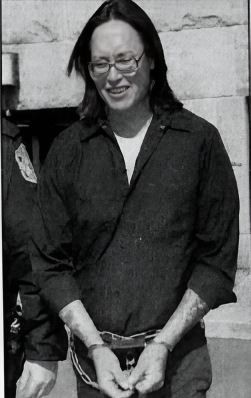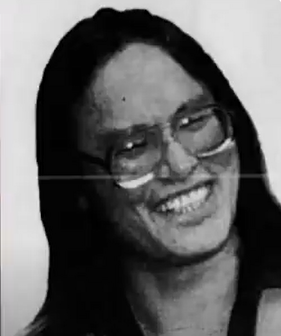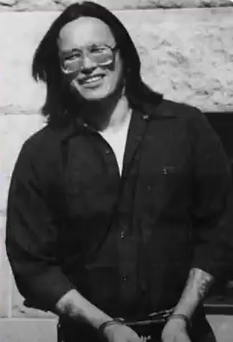
1954 - 1993
James Allen Red Dog
Summary
Name:
James Allen Red DogYears Active:
1973 - 1991Birth:
February 01, 1954Status:
DeceasedClass:
Serial KillerVictims:
5Method:
StabbingDeath:
March 03, 1993Nationality:
USA
1954 - 1993
James Allen Red Dog
Summary: Serial Killer
Name:
James Allen Red DogStatus:
DeceasedVictims:
5Method:
StabbingNationality:
USABirth:
February 01, 1954Death:
March 03, 1993Years Active:
1973 - 1991bio
Red Dog's ancestry was a combination of Dakota Sioux and Assiniboine. He belonged to the Dakota tribe and spent his childhood on the Fort Peck Reservation in Poplar, northeast Montana. He attributed his later criminal activities to the poverty on his reservation, citing the lack of jobs and the need to turn to crime to survive. A family acquaintance, who wished to remain anonymous, mentioned that at around 8 or 10 years old, Red Dog began to imitate an older half-brother he looked up to, who was in federal prison by 1993. This acquaintance also noted that Red Dog had very limited opportunities in life.
Delaware deputy attorneys Steven P. Wood and Peggy J. Hageman, who prosecuted Red Dog, were unable to identify a clear motive for his actions. Wood argued that attributing Red Dog's behavior solely to his upbringing oversimplifies the issue: "There is no denying the hardships faced by Native Americans on reservations, but the reality is that many endure these conditions without becoming multiple murderers," he said, adding that Red Dog's killings seemed "essentially motiveless."

However, six of Red Dog's eight sisters contested this portrayal, insisting he was not a "multiple and motiveless killer." They asserted that the people of Delaware should appreciate their brother's willingness to face the consequences of his actions, thereby saving taxpayers money on lengthy appeals.
murder story
In a television interview, Red Dog admitted that since his first significant crime, an armed robbery in 1973, he had always been "prepared to die." Alongside an accomplice, he robbed a liquor and pizza store on a reservation, during which the store owner was killed, leading to Red Dog receiving a 15-year prison sentence.
In 1977, during a jail furlough to attend a Native American ceremony, Red Dog escaped and fled to Los Angeles with a companion. There, they met two Native American men in a bar who offered them lodging for the night. They subsequently murdered the men in their sleep. Red Dog pleaded guilty to two counts of second-degree murder but received a concurrent sentence with his armed robbery conviction. Despite the gravity of the murders, he did not serve additional time for them. In 1983, while imprisoned in Illinois, he supplied heroin to kill Joe Ortega, a prison gang member.
In exchange for his testimony against other inmates and his cooperation in investigating prison gangs and the militant American Indian Movement, Red Dog entered the Federal Witness Protection Program and was paroled on June 27, 1990. After his release, he relocated to Delaware, where he murdered Hugh Pennington less than eight months later. Before the murder, Red Dog had been teaching Sioux traditions to Delaware's Nanticoke Indians.

At the time of Pennington’s murder, Red Dog was living with his wife Bonnie near Wilmington. On February 9, 1991, after a day of drinking, Red Dog appeared in Pennington's kitchen, woke him up, and forced him into a basement workshop. Enraged by a minor incident, Red Dog bound Pennington with duct tape and electrical cord and then slit his throat, nearly decapitating him.
Following the murder, Red Dog kidnapped a 52-year-old female witness, raped her multiple times, and forced her to drive him to southern Delaware. The woman eventually escaped and contacted the police.
Red Dog often referred to himself as a "terminator" and acknowledged his propensity for violence. His murder of Pennington led to a death sentence in April 1992. Red Dog, who refused to appeal the sentence, was captured by police four days after the murder, walking across Winchester Bridge in Wilmington, covered in deer feces to mislead police dogs. He claimed to have been too drunk to remember the murder and could not identify a motive, blaming his actions on childhood poverty and life in prison.

Red Dog requested the death penalty and refused to appeal, adhering to what he called his warrior's code. His family supported his decision. Red Dog became the second person executed in Delaware since the state reinstated the death penalty in 1992.
Red Dog's lawyer, Edward C. Pankowski Jr., unsuccessfully tried to persuade him to appeal. At the sentencing hearing, Red Dog declined to present mitigating evidence. The Delaware Superior Court judge found Red Dog competent to request execution and denied motions to block it.
Red Dog expressed a desire to expedite his execution for the sake of the victims' families and his own. His death sentence was automatically appealed under Delaware law but was eventually upheld. On March 3, Red Dog was executed by lethal injection at the State Correctional Center in Smyrna, Delaware. Before his execution, he received last rites from John H. Morsette, a tribal medicine man. Red Dog's final words were of gratitude to his supporters and curses to the rest of the witnesses. He was pronounced dead at 10:28 a.m., and his body was transported to Wolf Point, Montana.